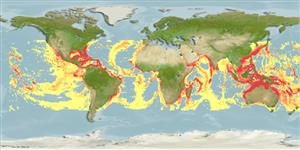Classificação / Names
Common names from other countries
Referência principal
Tamanho / Peso / Idade
Max length : 350 cm TL macho/indeterminado; (Ref. 9997); common length : 250 cm TL macho/indeterminado; (Ref. 9997); Peso máx. publicado: 346.0 kg (Ref. 40637); Idade máx. registada: 25 anos (Ref. 31395)
Length at first maturity
Lm 228.0, range 202 - 260 cm
Ambiente
; marinhas associadas(os) a recifes; oceanódromo (Ref. 51243); intervalo de profundidade 0 - 4000 m (Ref. 55180), usually 0 - 500 m (Ref. 6871)
Clima / Intervalo
Subtropical; 23°C - 24°C (Ref. 244), preferred 27°C (Ref. 107945); 42°N - 43°S, 169°W - 180°E (Ref. 55180)
Distribuição
Circumtropical. Western Atlantic: Massachusetts, USA to southern Brazil, including the Gulf of Mexico and the Caribbean Sea to Uruguay (Ref. 58839). Eastern Atlantic: Spain, Madeira to northern Angola; St. Paul's Rocks (Ref. 13121); Cape Verde (Ref. 34514). Indo-Pacific: scattered records from the Red Sea and Natal, South Africa (Ref. 5578) to China, New Zealand, and the Caroline, Hawaiian, Phoenix and Line islands. Eastern Pacific: southern Baja California, Mexico to northern Chile. Highly migratory species, Annex I of the 1982 Convention on the Law of the Sea (Ref. 26139).
Países | Áreas FAO | Ecossistemas | Ocorrências | Introduções
Descrição breve
Espinhos dorsais (total): 0; Raios dorsais moles (total): 0; Espinhos anais 0; Raios anais moles: 0. A large, slim shark with a moderately long, flat and rounded snout, large eyes, small jaws, and oblique-cusped teeth with serrations; 2nd dorsal fin low and with greatly elongated rear tip (Ref. 5578). Grey or bluish-grey above, white below; no conspicuous fin markings (Ref. 5578). Only Carcharhinus species with an interdorsal ridge that has the dorsal fin origin behind the free rear tip of the pectoral fin (Ref. 26938).
Categoria na Lista Vermelha da IUCN (Ref. 115185)
Ameaça para o homem
Traumatogenic (Ref. 9997)
Utilização humana
Pescarias: altamente comercial
Mais informação
ReferênciasAquaculturaPerfil para aquaculturaEstirpesGenéticaFrequência dos alelosHereditariedadeDoençasProcessamentoMass conversion
Ferramentas
Relatórios especiais
Descarregue XML
Fontes da internet
Estimates of some properties based on models
Phylogenetic diversity index
PD50 = 0.5000 many relatives (e.g. carps) 0.5 - 2.0 few relatives (e.g. lungfishes)
Nível Trófico
4.5 ±0.0 se; Based on diet studies.
Resiliência
Muito baixo, tempo mínimo de duplicação da população maior que 14 anos (rm=0.054; K=0.05-0.15; tm=6-10; tmax=25; Fec=2-14)
Vulnerabilidade
Very high vulnerability (79 of 100)
Categoria de preço
